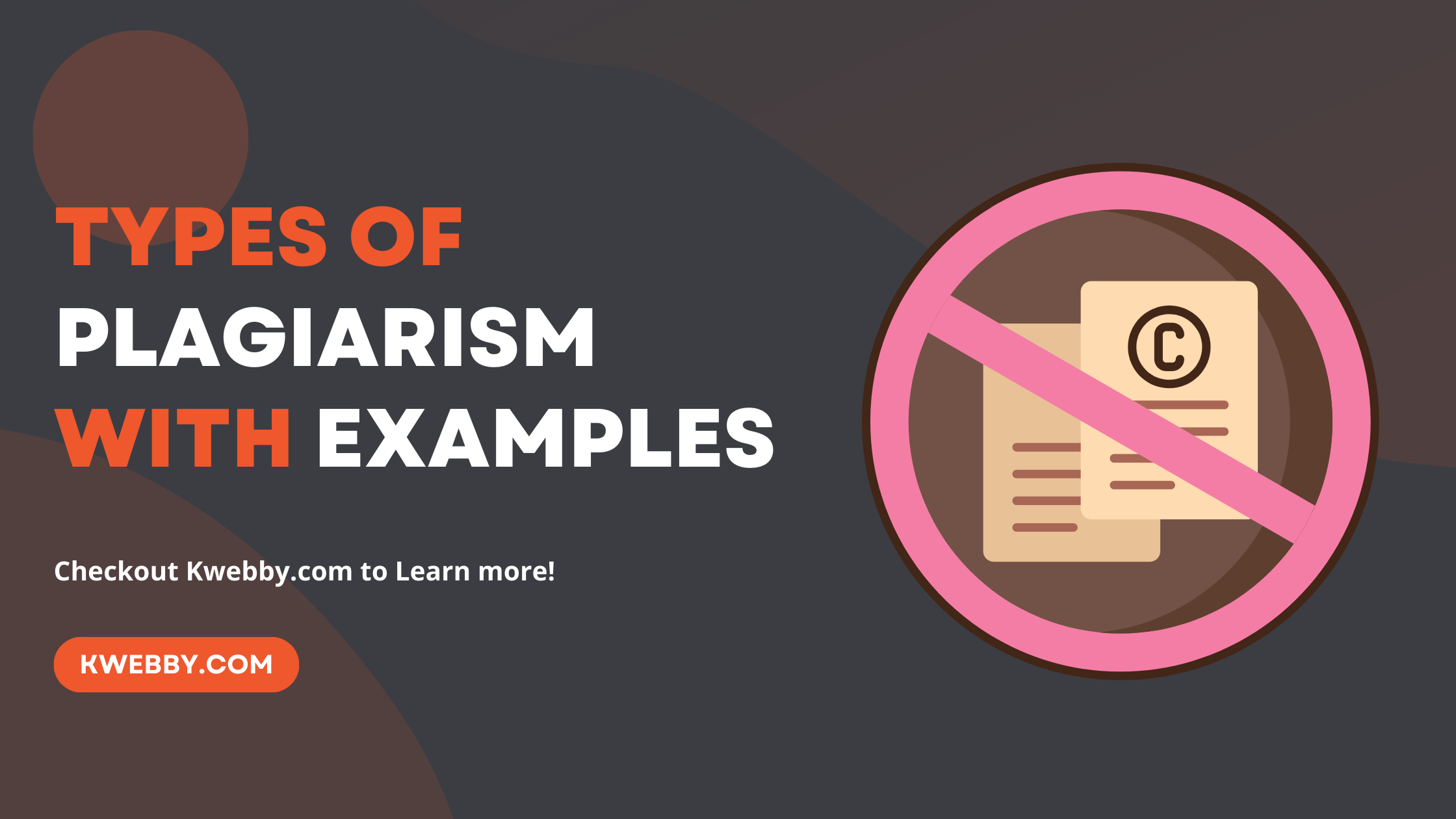
7 Types of Plagiarism (with Examples & Tips to Avoid)
Plagiarism, a serious academic and professional breach, manifests in various forms, each posing a threat to intellectual property rights and the sanctity of original work.
Understanding these types of plagiarism serves as the first step in preventing them. This article will explore the major types of plagiarism, providing clear definitions and illustrative examples.
We aim to foster a deeper understanding of this critical issue, helping individuals to navigate the intellectual landscape with integrity and respect for others’ work.
Check out the Free Plagiarism Checker Tool.
Common Types of Plagiarism
There are several types of plagiarism, and the following are among the most common:
Direct Plagiarism
Direct Plagiarism is one of the most common types of plagiarism and is often the result of laziness or dishonesty on the part of the individual. This type of plagiarism involves the word-for-word transcription of someone else’s work, without providing proper citation or using quotation marks. It is essentially stealing someone else’s words and presenting them as your own, which is a blatant violation of academic and professional ethics.
For example, let’s say a student borrows phrases verbatim from a research paper published in an academic journal for their term paper. The student does not use quotation marks nor does they cite the original author. This is a clear instance of direct plagiarism.
Grammarly Review 2024 (Does it live up to the hype?)
Complete Plagiarism
Complete plagiarism, also known as ‘global plagiarism’, is another common type of plagiarism that involves taking someone else’s work in its entirety and passing it off as one’s own. This act of dishonesty exceeds borrowing a few words or phrases—it’s akin to intellectual theft on a grand scale.
For instance, imagine a student enrolled in a literature course who is assigned a research paper. Instead of investing time and effort into their writing, the student locates a paper by another student from a previous semester (or perhaps from an online source) and submits it, word for word, as their own.
The student does not use their own words, change sentence structure, nor cite the original author—they merely present someone else’s work as their own. This is a clear example of complete plagiarism.
How to Check Plagiarism in Google Docs (4 Free Methods)
Self-Plagiarism
Self-plagiarism is a less obvious but equally significant type of plagiarism. This form of plagiarism occurs when an individual reuses significant portions of their work without acknowledging that they are doing so. It’s essentially presenting the same work in different contexts as if it is new content.
For instance, let’s take the example of a student who submits the same paper for assignments in two different classes without getting the professors’ approval. Or, this could be a researcher who republishes their research in multiple academic journals without citing their previous work. Both these instances are clear examples of self-plagiarism.
12 Best Plagiarism Checkers (All are Free!)
Paraphrasing Plagiarism
Paraphrasing plagiarism is one of the common types of plagiarism, where a person rewrites someone else’s work using their own words and phrases but keeps the same general structure and meaning of the original text. The underlying issue here is that the person neglects to attribute the ideas to the original author, thus presenting them as their own.
This type of plagiarism occurs when a student, for instance, reads research papers, and then rewrites the ideas using different words in their essays, but fails to properly cite the sources. This unintentional plagiarism could be avoided if the student accurately credits the original author’s work and uses quotation marks where necessary.
It’s crucial to understand and avoid paraphrasing plagiarism to maintain the integrity of one’s own writing and to respect the intellectual property rights of others.
Mosaic Plagiarism
Mosaic Plagiarism, also known as patchwork plagiarism, is a more covert form of plagiarism that involves blending someone else’s work with one’s writing. This type of plagiarism occurs when a writer finds synonyms for the author’s language or uses similar words and phrases but fails to cite the original author. It’s a subtle form of intellectual dishonesty that can often go unnoticed, especially if it is accidental plagiarism.
For example, suppose a college student is assigned a paper for a course. The student reads several research papers and unintentionally paraphrases the ideas into their essays, creating a ‘mosaic’ of other people’s work and their own words. They use similar phrases, borrow the structure of the original arguments, and weave in some of their thoughts, but they fail to provide proper attribution. This is a classic case of mosaic plagiarism.
Accidental Plagiarism
Accidental Plagiarism, also known as unintentional plagiarism, is one form of plagiarism that students often overlook in their own essays. This type most commonly occurs when students use someone else’s writing or ideas in their work without proper citation, not out of dishonesty but rather due to a lack of knowledge of citation rules or misunderstanding of what constitutes common knowledge. This is considered plagiarism nonetheless, as it represents a misleading attribution of the person’s work.
This becomes more complicated if the student integrates facts or information from their previous works into the same piece without previous permission from the professors involved. The students might think that since it’s their own work, they can reuse it freely. However, this practice without proper reference is considered self-plagiarism, which is also a form of plagiarism.
For instance, imagine a situation where a student submits a paper assigned during a college course. The student, in their way, paraphrases a secondary source but unintentionally includes phrases that are verbatim from the source, thereby creating a plagiarized text.
The student might be under the impression that changing a few of the writer’s words is enough to avoid plagiarism, but without providing adequate citations, this is still an instance of plagiarism.
Source-Based Plagiarism
Source-based plagiarism is one of the most common types of plagiarism that involves the unauthorized use or copying of phrases from a single source, presenting them as one’s work. It typically arises when a writer adopts the exact language of the source without providing accurate citations.
This form of plagiarism demonstrates a lack of original thought and can significantly compromise the credibility of the writer’s work.
For example, suppose a student is writing a research paper. They come across a particular source that articulates an idea or argument in a way that resonates with them. The student decides to incorporate these ideas into their paper, copying phrases verbatim from the source. They might believe that modifying a few words or reordering the sentence somewhat absolves them of the need to attribute the source.
However, this approach still constitutes source-based plagiarism, as the student is essentially taking someone else’s work and presenting it as their own, with only minor alterations. This case highlights the importance of comprehending and avoiding source-based plagiarism to uphold the integrity of one’s work.
Consequences of Plagiarism
Plagiarism, in any form, can have severe consequences, both academically and professionally. For students, the penalties can range from receiving a failing grade on the assignment or course to expulsion from the educational institution.
On the professional front, plagiarism can lead to loss of credibility, damage to reputation, and legal consequences. It could result in job termination and can hinder future career prospects.
In the publishing world, repercussions can include contract termination, legal action, financial penalties, and public apologies. The plagiarist’s work might be withdrawn, leading to a tarnished reputation in the literary community.
From a legal perspective, plagiarism can lead to lawsuits for copyright infringement, which can result in substantial fines and penalties.
On a personal level, plagiarism can affect one’s ethics, leading to feelings of guilt and regret. It also hampers personal growth and learning since plagiarists bypass the opportunity to develop their critical thinking, research, and writing skills.
Additional Tips for Avoiding Plagiarism
Here are some additional tips to help you avoid plagiarism and maintain academic integrity:
Understand Paraphrasing
Paraphrasing is not about swapping a few words with synonyms. It’s about understanding the original content and rewriting it in your own words while maintaining the original meaning. Ensure your version is genuinely distinct from the source.
Proper Citations
Always give credit where it’s due. If you’ve used someone else’s words or ideas, ensure you cite them correctly, following the preferred style guide (APA, MLA, etc.). When in doubt, cite.
Quote Correctly
If you use the same words as the original author, use quotation marks to indicate this. Be sure to quote sparingly, though; your work should primarily consist of your ideas.
Use Plagiarism Detection Tools
There are numerous plagiarism detection tools available online. Use these to cross-check your work and ensure your work is plagiarism-free.
Take Notes and Organize Your Research
Keep track of where you found specific ideas, and make a note of how you plan to use them in your work.
Understand Copyright and Fair Use
Familiarize yourself with copyright laws and the concept of fair use. This understanding will help you avoid legal issues related to intellectual property rights.
Avoid Self-Plagiarism
Remember that reusing your own previously published work without citation is also considered plagiarism. Always cite your own past work if you plan to reuse it.
Final Thoughts
Plagiarism, in its various forms, is a serious offense that undermines the values of academic and professional integrity. It’s essential to understand that any work, whether a student’s paper or a professional’s research, is a testament to their skills, intellect, and original thought.
By plagiarizing, individuals not only deceive their peers and superiors but also stunt their personal and intellectual growth. It’s vital to uphold the principles of honesty, respect for intellectual property, and personal responsibility in all facets of academic and professional life. Remember, the pursuit of knowledge is enriched by authenticity, critical thinking, and originality, not by the imitation of others’ work.





